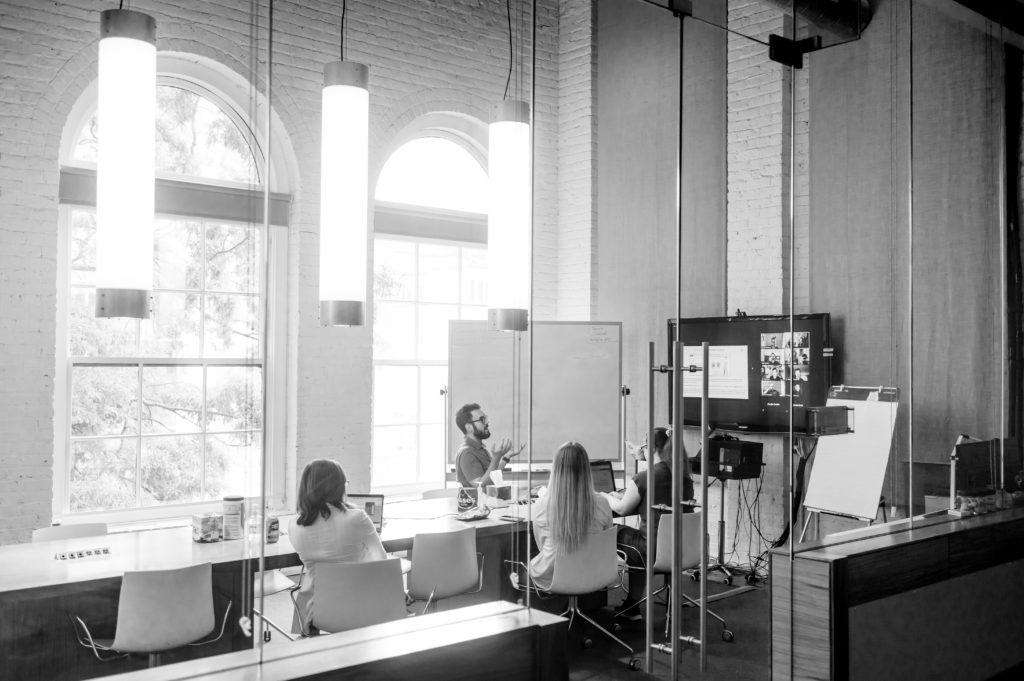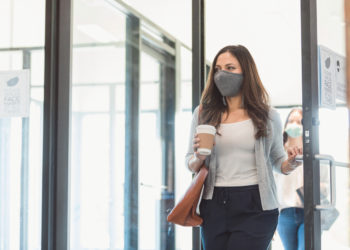Editor’s note: Today’s post is by Lily Garcia Walton. Lily is Chief People Officer at Silverchair in Charlottesville, VA.
“He allowed himself to be swayed by his conviction that human beings are not born once and for all on the day their mothers give birth to them, but that life obliges them over and over again to give birth to themselves.”—Gabriel García Márquez, Love in the Time of Cholera
In mid-February, I had the unsettling experience of walking into an upscale Charlottesville restaurant to find that I was the only person there wearing a mask and being told the policy was “whatever makes you feel comfortable.” After two years of a global pandemic with constantly changing health guidance and policies, the idea of simply “being comfortable” felt odd and foreign.
Clearly, COVID is not yet endemic. The CDC-reported community transmission rate in Albemarle County, Virginia (where Silverchair’s headquarters are located), remains at a “high” level (like the vast majority of US locales). Yet, the CDC has recently moved the goalpost on recommended masking in indoor public settings, shifting to a “Community Levels” map in which the vast majority of the US is now depicted as “low”. (It is worth noting that these changes are coming as many European countries are seeing a significant uptick in cases — especially from the BA.2 variant.) Around the same time, Virginia’s Governor (following a trend among US governors) signed an executive order repealing the requirement that children wear masks during the school day. Across the US and Europe, COVID-related mandates are being dissolved, but not based upon a scientifically grounded and consistent set of criteria. Apropos, an article published in Science last month warned of “endemic delusion”, fueled in part by recency bias from our experience of the more contagious and generally less severe Omicron variant (see also this article).
Given the conflicting and evolving messages about COVID safety from public health authorities and political leaders, it is harder than ever for business leaders to know what to do.

We have been challenged to look beyond traditional change management principles
Like many organizations, Silverchair’s change management protocol can be described in terms of Kotter’s 8-step process for leading change.
Ideally, our leaders are thinking ahead of the change, proactively communicating in a manner that both engages and inspires the community. We have time to build coalitions and recruit and deploy change champions who help to smooth the change curve across the organization. We also leave ourselves time to thoughtfully conceptualize and organize transitional routines and concepts that sketch a credible throughline from the past to the future.
Throughout the time of COVID, these traditional change management principles have often felt feeble and ineffective. There are a couple of good reasons for that:
- Change is happening to all of us, and it is uncertain. Change management principles generally work well in situations where the leadership of an organization is driving the change — or is at least ahead of the change curve. Our reality, by contrast, has been that we are all collectively experiencing change at the same time. Even as we are leading our organizations, we too, are human beings having a human experience of the pandemic in terms of personal loss, fear, depression, and exhaustion. This significantly dampens our ability to lead with the sort of reassuring and authoritative messages that tend to make people feel comfortable navigating change and embracing a more promising future. And it doesn’t help that our government leaders and public health authorities can’t seem to agree on what is actually happening — let alone what to do about it.
- We are not in the same boat. Even though we are all impacted by COVID-related changes, our lived experience — and where we locate ourselves along the change curve — continues to be highly variable based upon such factors as socioeconomic status; age; pre-existing health conditions; whether we are caregivers to young children, the elderly, and other people at greater risk for infection; and whether we have lost someone we care about to COVID. All of these factors impact our tolerance for risk and our sense of optimism about the future, which makes it hard to build coalitions and act decisively.
What, then, can we learn from current challenges that can carry us into the future?
Silverchair’s experience of the COVID-19 pandemic has been helped by the fact that we are a cohesive and caring community, deeply committed to our organization’s values.
Our Value #3 — “Solve problems with creativity & empathy” — has heavily informed our approach to the pandemic, especially during tense, controversial, or confusing times. We have drawn consistently upon the wisdom of our people, and we have been willing at all times to listen with interest and humility as we make decisions of consequence.
We have been guided by three anchoring principles, which have held up throughout the COVID-19 pandemic: (1) keep people safe; (2) make in real life (“IRL”) matter; and (3) lead with empathy. As you can imagine, these principles have been in tension to varying degrees. However, it is our willingness and desire to adhere to them that has resulted in a workplace that serves the need of our people to feel safe, to have some respite from a daily life dominated by the fear and isolation of COVID, and to have a sense of hope about the future.
1. Keep people safe
Above all, we have been guided by the commitment to keep our people safe — by which we mean actually safe, not simply performing hygiene theater. We have been persuaded by the science, which supports the idea that vaccinations are overwhelmingly safe and that those who receive the vaccine and a booster at an appropriate time are significantly less likely to become seriously ill or die from infection (for example: Morbidity and Mortality Weekly Report (MMWR)).
This is why Silverchair adopted a policy in May of 2021 requiring attestation of fully-vaccinated status as a prerequisite of working at our Charlottesville, Virginia headquarters. Several people wrote to thank us for the policy, which made them feel far more comfortable rejoining their colleagues in person. We also implemented a desk reservation app requiring people to answer questions regarding COVID symptoms and recent exposure every time they come to the office.
In addition to these precautions, we have been meticulous about following CDC guidelines regarding COVID exposure management, immediately reaching out to our public health authorities and potentially impacted members of our team when someone in our community tests positive. For almost a year, we have made COVID self-tests available to all our people on-demand free of charge — no questions asked. And, we have continued our policy of providing liberal time off for recovery related to COVID and vaccinations.
Admittedly, part of the reason our approach has worked is the fact that we are a relatively small company: about 120 people, who are part of a tight knit community in which it would be unspeakable to put a colleague at risk. Larger organizations could adopt our policies, but they might consider taking a more prescriptive approach — e.g., requiring actual proof of vaccination status (rather than an attestation).
2. Make IRL (“in real life”) matter
We have sought to make IRL at Silverchair as meaningful as possible. Even though we have been requiring people to be fully vaccinated as a prerequisite to working in our offices for nearly a year, we continued to require masking until January of 2022, when it became optional. We decided that our building access controls restricting public entry, our low occupancy rate (~10% of our people in office on any given day), our strict vaccination requirements, and our daily health checks provide sufficient protection to our people.
The primary driver of this decision was our desire to make working in the office an attractive option for Silverchairians, hopefully enticing them to leave their home offices in favor of occasional collocated work.
As I have written before, Silverchair embraces the immense benefits of collocation in terms of collaboration, creativity, and communication. At the same time, our leadership team has also committed to a remote-first work model, by which we mean that we will not be reverting to a time when we required all our people to work together in person. Our strategy is based on persuasion rather than coercion. Rather than assuming the burden is on our people to prove to us why they should be permitted to work remotely, we have instead decided that the burden is upon the stewards of Silverchair to make our office a state-of-the-art coworking space people look forward to enjoying.
We have continued renovations, adding to our list of unique people-centered features: two wellness rooms (suitable for nursing mothers or for meditation, yoga, and rest); attractively decorated and ergonomically fitted collaboration spaces; and a “Silver Bistro” complete with dining area, espresso maker, and a full bar for company social gatherings. This month, that space hosted a celebration of Employee Appreciation Day, our first ever in-person event at Silverchair headquarters since the start of the pandemic. With high fidelity to our safety protocols, about a third of the company chose to come to work in person for the day, and the office audibly buzzed with colleagues excitedly reconnecting with those they hadn’t seen IRL in almost 2 years. It mattered, indeed.
3. Lead with empathy
It would have been unthinkable pre-pandemic for most people to say aloud in a professional forum that they are having a hard week, that they are feeling anxious, that they despair. If there is any silver lining to our collective experience of these past two years, it is the normalization of what it means to be human in a professional context.
Every organization’s change management superpower is the capacity for empathy—by which I mean not just having tolerance for human struggle, but also creating space for people to be people, establishing a baseline of psychological safety that allows everyone to be both imperfect and okay.
At Silverchair, we have been doubling down on creating forums to listen to what our people have to say, taking immediate action on things that can be fixed and being honest about what will take more time. We have created regular leadership roundtables for some of our mission-critical role groups where we know we have opportunities to create a more sustainable experience. We have established a Silverchairian Advisory Group called the Ag that serves as a sounding board on cultural and policy decisions. We have deployed an annual organizational health survey, with studious follow-up on our results. And, we have pivoted to a strengths-based performance management system in which we take careful inventory of everyone’s potential even as we are evaluating their performance in role.
These are just some examples of the steps we have taken to more deeply understand and humanize what it means to be a Silverchairian—imperfect, intelligent, quirky, inimitable. As organizations continue to find their footing in the ever-shifting sands of the pandemic workplace, with guidance that slips through our fingers just as we grasp for stability, sometimes the best we can do is show up with authenticity to define what “being comfortable” means for our people in the hopeful future we are together creating.
Discussion
5 Thoughts on "Guest Post — Love in the Time of COVID: Lessons in Change Management and Hope Amid the Chaos"
You are describing a culture that sounds like it would be ideal for retaining employees who have adapted to working at home. Thank you for this post. The image of the hybrid meeting prompts me to ask if new cameras and technology were acquired to enable a wide view of the group in the office. Or had it been designed that way from the start?
Thanks for the question, Judy. The cameras in the conference rooms were already there pre-pandemic. But, to be honest, we have found that the most effective hybrid modality is when everyone who is IRL uses their individual computer cameras so those who are WFH can participate on a level footing. Please feel free to email me at lgarciawalton@silverchair.com if you’d like to chat more!
Ensuring equity between the group of people ‘in the room’ and the individuals who are ‘remote’ is very challenging, especially if the proportion of remote people drops below something like 50% of the participants.
Using individual webcams for each person in the meeting room can help, and the ultimate expression of this is where the people in the office join from their separate locations in the building, but this feels like a very clunky workaround.
For the fully-hybrid workshops at the R2R Conference (which I Chaired) in February, we typically had about 50:50 online and physical, and we set it up so that:
– all the online people were ‘together’ in a shared virtual space (using Spatial Chat), rather than isolated in their Zoom rectangles,
– all shared documents, were shared within the virtual space, so these were visible to all participants in the same environment,
– physical participants could see and hear all the online participants, with a focus on any active speaker,
– online participants could see and hear the whole group ‘in the room’, with a focus on any active speaker.
It was challenging to set up and operate, but worked well.
You can get a bit of a sense of how it looked from the pictures here:
https://r2rconf.com/r2r-history-2022-gallery/
Thanks for the question, Judy. The cameras in the conference rooms were already there pre-pandemic. But, to be honest, we have found that the most effective hybrid modality is when everyone who is IRL uses their individual computer cameras so those who are WFH can participate on a level footing. Please feel free to email me at lgarciawalton@silverchair.com if you’d like to chat more!
Everything I’ve read says the most important “policy” to care for your employees is an upgraded ventilation system. And for people to never say the words, “It is just an allergy.” Congrats on letting employees work from where they are comfortable.



